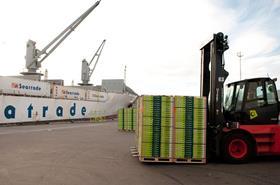
New Zealand’s kiwifruit season has got off to a solid start this year, and the first full reefer vessels are due to head out to international markets in the last two weeks of the month.
The crop has had almost ideal growing conditions this year, with a warm, moist summer giving growers good-sized fruit with high sugar levels and dry matter, if not quite as high on average as last year’s heat-pumped harvest.
Overall volumes will be on par with the last few years at around 100m trays (18kg), roughly 73m of which are Hayward and 26m of which are Zespri Gold (Hort16A).
“Most people are pretty happy with the size of the crops they’ve got, and the quality and volume. It’s a good season,” said Peter Ombler, president of peak body New Zealand Kiwifruit Growers Inc (NZKGI).
Marketing
Demand for early fruit has been particularly strong so far, according to single-desk marketer Zespri, although buyers have had to wait slightly later than last year, with fruit running behind the very early 2010 crop.
“The first vessel will depart at the end of the month to Japan, and is due to arrive in mid-April,” detailed Zespri’s Melanie Palmer. “Then there are two going in one week to China, and then up to Europe shortly after that.”
Demand in Japan is still in limbo following the earthquake and tsunami earlier this month, and Zespri’s own operations in the country are still running in station-keeping mode.
“It’s just too soon to say `what the impact has been`,” explained Ms Palmer. “We only have a skeleton staff in our Tokyo office, which is still dealing with aftershocks. We’ll be considering the sales implications over the next few weeks.”
In Europe, Zespri expects to have a strong presence with New Zealand kiwifruit in supermarkets by May, and will enter the season on the back of another strong suite of promotions. Marketing in Europe will follow on from previous years with a focus on overall category growth and a message of health and nutrition. The campaign will include in-store sampling, retail roadshows and television advertising.
In North America, Zespri’s strategy is instead focusing on strong cooperation with retail chains, which provide the bulk of the company’s distribution network.
“We’re making sure there is strong support for the retailers with in-store merchandising, in store sampling and point of sale material,” Zespri’s director of corporate and grower services Carol Ward said.
Zespri also announced in mid-March the winners of its 2010 Great Kiwi Adventure promotion, handing out all-expenses-paid tours of the Bay of Plenty region for one consumer and one food blogger along with three friends each.
The competition, put together by Zespri, Air New Zealand and Tourism Bay of Plenty, was run in the US market during the 2010 season, and will be run again in 2011, according to Ms Ward.
“We’re really trying to link in with a strong New Zealand provenance; it’s a real link with where the kiwifruit comes from,” she said. “We’ll be running the same promotion again this year.”
New varieties
Zespri also expects to this year finalise the market position of the new kiwifruit varieties it released to commercial development last year. Consumer testing of the new varieties, a sweet green and one early and one late gold-fleshed cultivar, will pin down a relationship to Zespri’s current products.
This year’s testing, with greater volumes as early plantings mature, is of critical importance to establishing the extent of the early and late gold varieties’ timings in particular.
“We do need to put them through the supply chain with greater volumes and make sure they delivers on those attributes,” stated Ms Ward. “We’ve got confidence that these varieties taste great, we’re testing the supply chain performance.”
All three varieties have had strong interest in Asia, particularly in Japan. The Zespri board is due to meet in June to make a decision on further releases of grower licences for the new varieties, and Ms Ward said the company will need answers to some of those questions by that point. The company is currently hard at work developing branding for the three.
Zespri’s next varieties in the testing pipeline are two red-fleshed cultivars, currently still in commercial block trials. Volumes are high enough this year to be able to send fruit to export markets for consumer testing.
“Before too long we’ll have a great opportunity for a red cultivar in the Zespri brand,” predicted Ms Ward. “But this year is still a year of testing and trialling.”
The new red kiwifruit are looking promising to growers as well, and Mr Ombler described them as “particularly encouraging”.
“As a grower, what I saw excited me. Red varieties are difficult by nature…`but` some of the cultivars that are there from grower and market perspectives look good. I think there’s every reason to be quite optimistic.”



